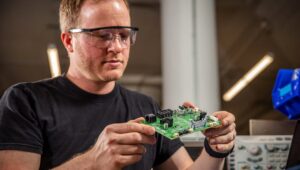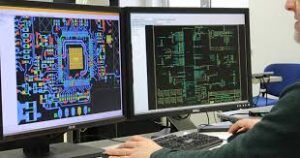Practical PCB layout tips
PCB design engineers often draw the most attention to circuits, the latest components, and code as important parts of an electronics project, but sometimes overlook the PCB layout of key components of the electronics. Poor PCB layout can lead to functionality and reliability issues. This article contains practical PCB layout tips that can help your PCB project work correctly and reliably.
line width line spacing
Real-world copper alignments have resistance. This means that the alignment will have a voltage drop as current flows through it, and power consumption and temperature increase. Resistance is defined by the following equation:
$$ R = \ frac {(resistivitylength)} {(thicknesswidth)} $$
PCB designers most often use length, thickness, and width to control the resistance of PCB alignments. Resistance is a physical property of the metal used to make the alignment. PCB designers can’t really change the physical properties of copper, so focus on controllable alignment sizes.
PCB alignment thickness is measured in ounces of copper. If we distribute 1 ounce of copper evenly over an area of 1 square foot, we will measure the thickness as one ounce. This thickness is one thousandth of an inch. Many PCB designers use 1 oz or 2 oz of copper, but many PCB manufacturers can provide thicknesses of 6 oz. Please note that it is difficult to make thin features like thick pins. Consult your PCB manufacturer about their capabilities.
Use the PCB trace width calculator to determine the width and width of the traces that are appropriate for your application. Aim for a temperature rise of 5°C. If there is extra space on the board, use larger traces, as they will not cost anything.
When building multilayer boards, keep in mind that the alignment on the outer layers dissipates heat better than the alignment on the inner layers because the heat from the inner layers must pass through layers of copper and PCB material before it can be conducted, radiated, or connected.
Make the loop smaller
Loops, especially high frequency loops, should be as small as possible. Smaller loops have lower inductance and resistance. Placing loops on the grounding layer can further reduce inductance. Having a small loop reduces high frequency voltage spikes caused by $$ V = L \ frac {di} {dt} $$. Small loops also help reduce the amount of signal that is inductively coupled into or broadcast from the node from external sources. Unless you are designing an antenna, this is what you want. Also, for op-amp circuits, make the loops small to prevent noise from coupling into the circuit.
Decoupling capacitor placement
Decoupling capacitors should be placed as close to the power and ground pins of the IC as possible to maximize decoupling efficiency. Capacitors that are placed farther away introduce stray inductance. Multiple vias from the capacitor pins to the ground level can reduce inductance.















